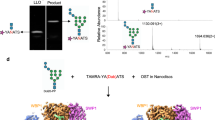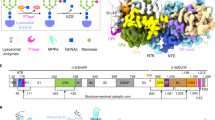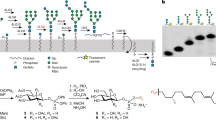Abstract
SCFFbs1 is a ubiquitin ligase that functions in the endoplasmic reticulum (ER)-associated degradation pathway. Fbs1/Fbx2, a member of the F-box proteins, recognizes high-mannose oligosaccharides. Efficient binding to an N-glycan requires di-N-acetylchitobiose (chitobiose). Here we report the crystal structures of the sugar-binding domain (SBD) of Fbs1 alone and in complex with chitobiose. The SBD is composed of a ten-stranded antiparallel β-sandwich. The structure of the SBD–chitobiose complex includes hydrogen bonds between Fbs1 and chitobiose and insertion of the methyl group of chitobiose into a small hydrophobic pocket of Fbs1. Moreover, NMR spectroscopy has demonstrated that the amino acid residues adjoining the chitobiose-binding site interact with the outer branches of the carbohydrate moiety. Considering that the innermost chitobiose moieties in N-glycans are usually involved in intramolecular interactions with the polypeptide moieties, we propose that Fbs1 interacts with the chitobiose in unfolded N-glycoprotein, pointing the protein moiety toward E2 for ubiquitination.
This is a preview of subscription content, access via your institution
Access options
Subscribe to this journal
Receive 12 print issues and online access
$189.00 per year
only $15.75 per issue
Buy this article
- Purchase on Springer Link
- Instant access to full article PDF
Prices may be subject to local taxes which are calculated during checkout




Similar content being viewed by others
References
Hershko, A., Ciechanover, A. & Varshavsky, A. Basic Medical Research Award. The ubiquitin system. Nat. Med. 6, 1073–1081 (2000).
Pickart, C.M. Mechanisms underlying ubiquitination. Annu. Rev. Biochem. 70, 503–533 (2001).
Weissman, A.M. Themes and variations on ubiquitylation. Nat. Rev. Mol. Cell. Biol. 2, 169–178 (2001).
Deshaies, R.J. SCF and Cullin/Ring H2–based ubiquitin ligases. Annu. Rev. Cell. Dev. Biol. 15, 435–467 (1999).
Winston, J.T., Koepp, D.M., Zhu, C., Elledge, S.J. & Harper, J.W. A family of mammalian F-box proteins. Curr. Biol. 9, 1180–1182 (1999).
Ilyin, G.P. et al. A new subfamily of structurally related human F-box proteins. Gene 296, 11–20 (2002).
Yoshida, Y. et al. E3 ubiquitin ligase that recognizes sugar chains. Nature 418, 438–442 (2002).
Yoshida, Y. et al. Fbs2 is a new member of the E3 ubiquitin ligase family that recognizes sugar chains. J. Biol. Chem. 278, 43877–43884 (2003).
Zheng, N. et al. Structure of the Cul1-Rbx1-Skp1-F boxSkp2 SCF ubiquitin ligase complex. Nature 416, 703–709 (2002).
Wu, G. et al. Structure of a β-TrCP1-Skp1–β-catenin complex: destruction motif binding and lysine specificity of the SCF(β-TrCP1) ubiquitin ligase. Mol. Cell 11, 1445–1456 (2003).
Orlicky, S., Tang, X., Willems, A., Tyers, M. & Sicheri, F. Structural basis for phosphodependent substrate selection and orientation by the SCFCdc4 ubiquitin ligase. Cell 112, 243–256 (2003).
Schulman, B.A. et al. Insights into SCF ubiquitin ligases from the structure of the Skp1-Skp2 complex. Nature 408, 381–386 (2000).
Plemper, R.K. & Wolf, D.H. Retrograde protein translocation: ERADication of secretory proteins in health and disease. Trends Biochem. Sci. 24, 266–270 (1999).
Fiedler, K. & Simons, K. The role of N-glycans in the secretory pathway. Cell 81, 309–312 (1995).
Helenius, A. & Aebi, M. Intracellular functions of N-linked glycans. Science 291, 2364–2369 (2001).
Ellgaard, L., Molinari, M. & Helenius, A. Setting the standards: quality control in the secretory pathway. Science 286, 1882–1888 (1999).
Holm, L. & Sander, C. Protein structure comparison by alignment of distance matrices. J. Mol. Biol. 233, 123–138 (1993).
Seetharaman, J. et al. X-ray crystal structure of the human galectin-3 carbohydrate recognition domain at 2.1-Å resolution. J. Biol. Chem. 273, 13047–13052 (1998).
Simpson, P.J. et al. The solution structure of the CBM4-2 carbohydrate binding module from a thermostable Rhodothermus marinus xylanase. Biochemistry 41, 5712–5719 (2002).
Petrescu, A.J., Petrescu, S.M., Dwek, R.A. & Wormald, M.R. A statistical analysis of N- and O-glycan linkage conformations from crystallographic data. Glycobiology 9, 343–352 (1999).
Vyas, N.K. Atomic features of protein–carbohydrate interactions. Curr. Opin. Struct. Biol. 1, 732–740 (1991).
Quiocho, F.A. Carbohydrate-binding proteins: tertiary structures and protein–sugar interactions. Annu. Rev. Biochem. 55, 287–315 (1986).
Williams, R.L., Greene, S.M. & McPherson, A. The crystal structure of ribonuclease B at 2.5-Å resolution. J. Biol. Chem. 262, 16020–16031 (1987).
Leslie, A.G.W. Molecular data processing. Crystallographic Computing 5, 50–61 (1991).
Kabsch, W. Evaluation of single-crystal X-ray diffraction data from a position-sensitive detector. J. Appl. Crystallogr. 21, 916–924 (1988).
Collaborative Computational Project, Number 4. The CCP4 suite: programs for protein crystallography. Acta Crystallogr. D 50, 760–763 (1994).
Wang, B.C. Resolution of phase ambiguity in macromolecular crystallography. Methods Enzymol. 115, 90–112 (1985).
Zhang, K.Y.J. & Main, P. The use of Sayre's equation with solvent flattening and histogram matching for phase extension and refinement of protein structures. Acta Crystallogr. A 46, 377–381 (1990).
Perrakis, A., Morris, R. & Lamzin, V.S. Automated protein model building combined with iterative structure refinement. Nat. Struct. Biol. 6, 458–463 (1999).
Jones, T.A., Zou, J.Y., Cowan, S.W. & Kjeldgaard. Improved methods for building protein models in electron density maps and the location of errors in these models. Acta Crystallogr. A 47 (Part 2), 110–119 (1991).
Murshudov, B.W. Refinement of macromolecular structures by the maximum-likelihood method. Acta Crystallogr. D 53, 240–255 (1997).
Navaza, J. An automated package for molecular replacement. Acta Crystallogr. A 50, 157–163 (1994).
Kawakami, T. et al. NEDD8 recruits E2-ubiquitin to SCF E3 ligase. Embo J. 20, 4003–4012 (2001).
Clore, G.M. & Gronenborn, A.M. Multidimensional heteronuclear nuclear magnetic resonance of proteins. Methods Enzymol. 239, 349–363 (1994).
Acknowledgements
We thank Y. Wada for her help in the preparation of isotopically labeled recombinant proteins and E. Adachi for expert technical assistance. This work was supported in part by Grants-in-Aid from the Ministry of Education, Science and Culture of Japan (K.T. and K.K.), Japan Society for the Promotion of Science and Mizutani Foundation for Glycoscience (K.K.), and in part by the National Project on Protein Structural and Functional Analyses from the Ministry of Education, Culture, Sport, Science and Technology of Japan (T.T.).
Author information
Authors and Affiliations
Corresponding author
Ethics declarations
Competing interests
The authors declare no competing financial interests.
Supplementary information
Rights and permissions
About this article
Cite this article
Mizushima, T., Hirao, T., Yoshida, Y. et al. Structural basis of sugar-recognizing ubiquitin ligase. Nat Struct Mol Biol 11, 365–370 (2004). https://doi.org/10.1038/nsmb732
Received:
Accepted:
Published:
Issue Date:
DOI: https://doi.org/10.1038/nsmb732
This article is cited by
-
FBXO2 targets glycosylated SUN2 for ubiquitination and degradation to promote ovarian cancer development
Cell Death & Disease (2022)
-
Back2Basics: animal lectins: an insight into a highly versatile recognition protein
Journal of Proteins and Proteomics (2022)
-
An engineered high affinity Fbs1 carbohydrate binding protein for selective capture of N-glycans and N-glycopeptides
Nature Communications (2017)
-
The cullin protein family
Genome Biology (2011)
-
Diversity of degradation signals in the ubiquitin–proteasome system
Nature Reviews Molecular Cell Biology (2008)



